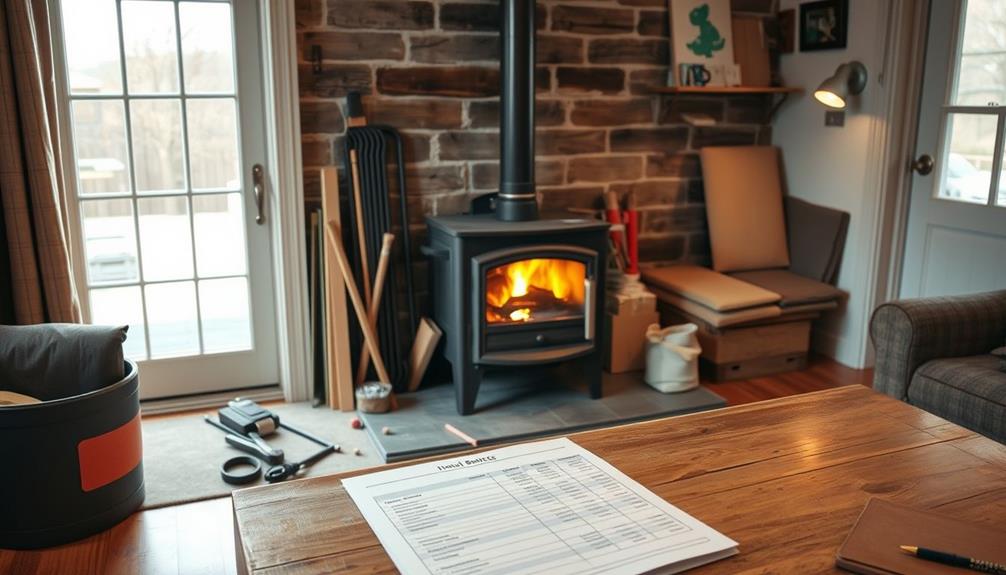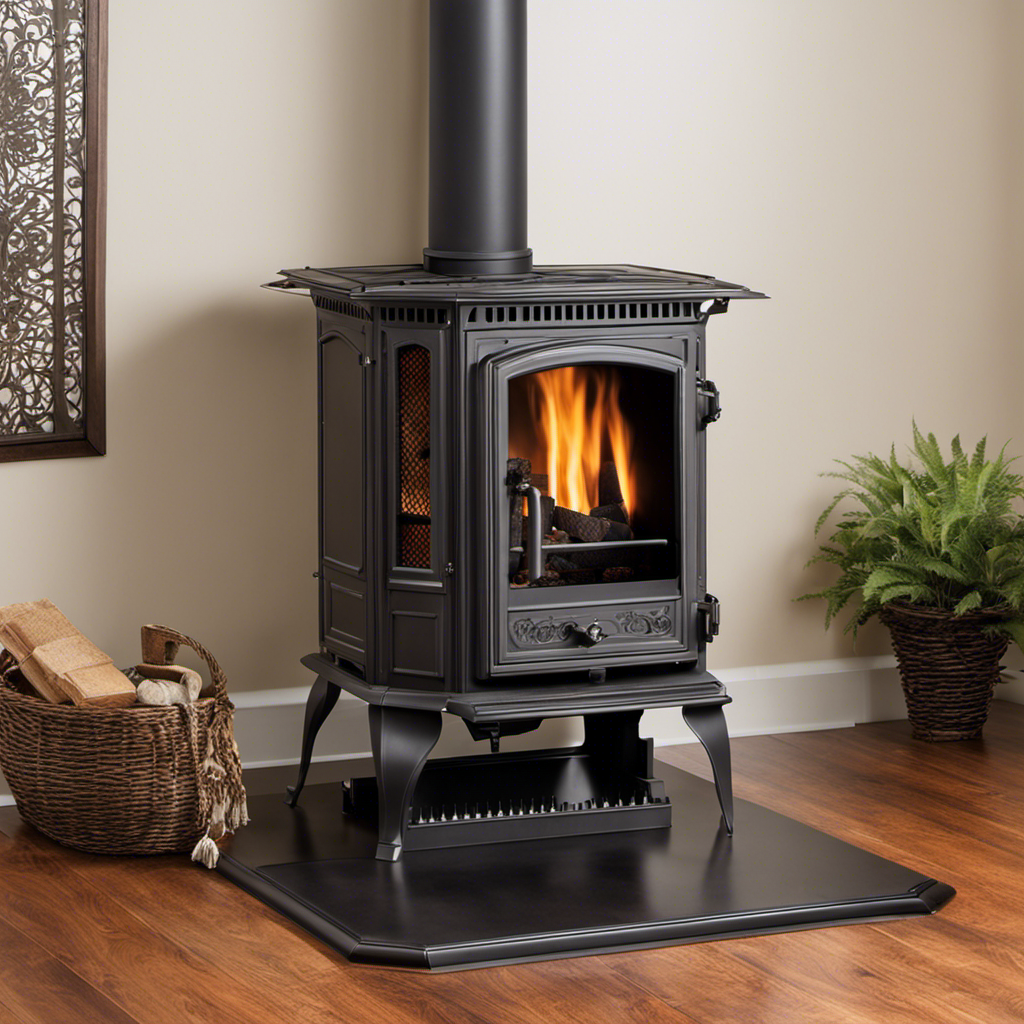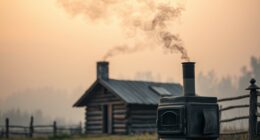To properly dispose of ashes from your wood stove, start by letting them cool completely for at least 96 hours. Once cooled, store the ashes in a covered metal container, keeping it at least 10 feet away from any structures or flammable materials. Always avoid using plastic or cardboard for disposal. Before throwing them away, double-check for any hidden embers after a week. This precaution helps prevent accidental fires. By following these guidelines, you'll guarantee safety in your home while responsibly managing ash waste. There's more to discover about recycling and using those ashes creatively, so keep exploring!
Key Takeaways
- Allow ashes to cool completely for at least 96 hours to ensure all embers are extinguished.
- Store cooled ashes in a covered metal container, keeping it at least 10 feet away from structures.
- Regularly inspect ash containers for heat or smoldering ashes to prevent fire hazards.
- Dispose of ashes safely without using flammable materials like plastic or cardboard.
- Use wood stove ashes creatively as fertilizer, pest deterrents, or traction on icy surfaces.
Importance of Proper Ash Disposal
When it comes to disposing of wood stove ashes, understanding the importance of proper ash disposal is fundamental for your safety and that of your home. Improper disposal practices can lead to devastating fire hazards, especially during the fall and winter months when fires are more common.
To minimize the risk of accidental ignitions, you should always verify that the ashes are completely cooled—ideally, you need to wait at least 96 hours before disposing of them. Additionally, using a safe method for ash collection is essential; consider using a safety glasses to protect your eyes during the process.
Using a covered metal bucket is critical for safe ash disposal. This container should be placed at least 10 feet away from your home and any other structures. By doing this, you'll markedly reduce the chances of stray embers causing a fire.
Regularly check on your stored ashes, as they can still harbor hot embers, posing a threat if not managed properly.
Cooling and Containment of Ashes

Properly cooling and containing wood stove ashes is vital for guaranteeing safety in your home. After you're done using your stove, allow the ashes to cool completely for at least 96 hours. This waiting period guarantees that all embers are extinguished, minimizing any fire hazards.
In addition, it's important to recognize that improper disposal can lead to increased risks of fire and environmental issues, similar to the problems caused by flushing non-flushable items in toilets, which can result in costly plumbing repairs clogging remedies.
Once the ashes are cooled, store them in a covered metal container. Metal is vital here; it prevents accidental ignition and reduces the risk of fires.
Never use plastic, cardboard, or paper for ash disposal, as these materials can ignite easily. After a week, check the ashes again to confirm they remain cool before final disposal. If they're still safe, you can dispose of them in the trash.
Remember to keep the ash container at least 10 feet away from any structures to further minimize potential fire risks.
Safe Placement of Ash Containers

To guarantee safety, positioning your metal ash containers correctly is vital. Always place them at least 10 feet away from any structures to minimize fire risks. This distance reduces the chance of heat or sparks reaching nearby buildings.
Make certain your ash containers are also positioned away from flammable materials like firewood piles, garages, and decks, which could easily ignite. Additionally, it's useful to take into account the importance of using essential items for a home cleaning kit when maintaining your space around the stove, as this can help prevent the accumulation of any debris that might catch fire.
Avoid placing ash containers under porches or in enclosed spaces. These areas can trap heat and create fire hazards if the ashes are still warm or smoldering. Regularly check your ash containers for any signs of heat or smoldering ashes, especially after storing them for a week.
When it comes to proper disposal, use only covered metal containers for your ashes. Unlike plastic or cardboard, metal won't easily ignite and contributes to fire hazards.
Following these guidelines will help guarantee that your ash disposal is safe, preventing potential accidents and keeping your home secure. By prioritizing the safe placement of ash containers, you're taking a vital step in fire prevention and safety.
Fire Safety Precautions

In the midst of enjoying the warmth from your wood stove, it is vital to prioritize fire safety precautions to protect your home and loved ones. By taking simple steps, you can keep your house safe from potential fire hazards.
| Fire Safety Precautions | Description |
|---|---|
| Maintain a Three-Foot Clearance | Keep a three-foot distance around heating appliances to prevent accidental fires. |
| Establish a Kid-Free Zone | Create a safe area away from open fires to protect children from burns. |
| Use Sturdy Screens | Install screens on fireplaces to prevent sparks from escaping and igniting nearby materials. |
Never leave fires unattended, especially when children are around. This minimizes the risk of accidental burns or fires. Regularly inspect your heating equipment to verify it's functioning safely and to identify any potential hazards.
Proper disposal of hot ashes is vital, as improper disposal can lead to devastating fires. Always follow these steps to guarantee safety and remember to check with your local fire protection district for additional guidance. Prioritizing these fire safety precautions will help you enjoy your wood stove responsibly.
Community Resources and Programs

You can take advantage of community resources that support safe wood stove ash disposal. Many local fire districts offer programs that provide specialized ash containers, while organizations like TahoeLivingWithFire offer workshops and educational materials.
Additionally, implementing sustainable practices like composting certain types of wood ashes can enhance your garden's soil quality, promoting self-sufficiency in your food production (DIY Power Sources).
Engaging with these resources not only guarantees your safety but also helps build a stronger fire prevention culture in your neighborhood.
Local Fire District Programs
Many communities benefit from local fire district programs that focus on the safe disposal of wood stove ashes. These programs provide essential guidance for proper disposal, greatly reducing fire risks associated with improperly discarded ashes. Local fire districts often supply metal ash containers designed to minimize hazards, ensuring you can dispose of your ashes safely.
Implementing safe disposal practices is vital for maintaining a fire-safe environment, similar to the importance of quality assurance in software development.
In addition to providing resources, many fire districts conduct educational workshops to raise awareness about fire safety. These workshops teach you the vital importance of managing ash disposal effectively, helping to prevent home and wildland fires. Participating in these sessions can enhance your understanding of best practices and local fire safety regulations.
Moreover, local fire districts value community engagement, encouraging residents to report unsafe ash disposal practices they observe. This proactive approach fosters a culture of safety and prevention within your community.
Community Engagement Initiatives
Community engagement initiatives play an essential role in promoting fire safety and effective ash disposal practices. By actively participating in your community's programs, you can enhance awareness and encourage safe disposal methods for wood stove ashes.
Incorporating elements of sustainable practices, such as those found in eco-pool innovations, can also inspire more environmentally friendly ash disposal solutions. Here are three ways you can get involved:
- Attend Workshops: Join local fire safety workshops that focus on proper disposal techniques, helping you learn best practices for handling ashes from your fireplace.
- Utilize Local Resources: Connect with organizations like TahoeLivingWithFire, which provide valuable information on ash disposal guidelines and fire prevention initiatives.
- Volunteer for Community Events: Participate in community engagement events aimed at educating others about fire safety and the importance of proper ash disposal, reducing fire hazards in your neighborhood.
Engaging with these initiatives not only helps you stay informed but also fosters a culture of safety in your community.
By leveraging local resources and sharing knowledge, you can contribute to a safer environment for all.
Risks of Improper Ash Disposal

Improperly disposing of wood stove ashes can create serious fire hazards in your home. Hot ashes can stay warm for days, and if they're placed in flammable containers or near combustible materials, you risk igniting a fire.
It's vital to guarantee proper ventilation during disposal, as it mitigates risks associated with heat buildup.
Additionally, being aware of energy consumption patterns can help you manage overall safety in your home.
It's important to follow safe disposal practices to protect your property and well-being.
Fire Hazards Overview
Hot ashes can pose a serious fire hazard if not disposed of correctly. The improper disposal of hot ashes from the fireplace is a leading cause of home fires, often due to a lack of awareness about their risks.
Many people don't realize that seemingly harmless ashes can smolder for days, leading to devastating consequences. Regular use of air purifiers can help reduce indoor air pollutants that may arise from smoke or ash.
Here are three major causes of fire hazards that you should be aware of:
- Plastic containers: These can easily combust when in contact with hot ashes, igniting a fire that can spread rapidly.
- Improper storage: Leaving ashes in a pile or unmonitored can lead to unexpected flare-ups, especially if they come into contact with flammable materials.
- Lack of metal receptacles: Always use a metal shovel and a metal container for the disposal of fireplace ashes, as these materials handle heat better and reduce fire risks.
Regular monitoring and safe disposal practices are essential for preventing potential disasters.
Long-lasting Ember Risks
Even when ashes appear cool to the touch, they can still harbor hidden embers that reignite, creating a serious fire risk. Hot ashes can retain these long-lasting embers for days, which is why proper disposal is essential.
The National Fire Protection Association (NFPA) highlights that improper disposal of ashes is a leading cause of residential fires, particularly during the fall and winter months.
Using combustible containers, like plastic or cardboard, for ash disposal greatly increases the fire hazard. Many fires have started from seemingly cool debris that reignited due to hidden embers within the ashes.
To mitigate this major fire risk, always monitor your ashes closely and adopt safe disposal practices.
It's important to let ashes cool completely in a metal container, away from flammable materials, before disposing of them in a designated outdoor area.
Regularly checking for hidden embers can substantially reduce the risk of fire incidents related to long-lasting embers. By taking these precautions, you can guarantee your home remains safe and free from potential fire hazards caused by improper ash disposal.
Creative Uses for Ash

When it comes to creative uses for wood stove ashes, you'll be surprised at their versatility. These ashes aren't just waste; they can enhance your garden, improve safety, and even help in crafting!
Additionally, utilizing sustainable practices in your home can contribute to a more eco-friendly lifestyle, much like the benefits of geothermal energy for heating and power solutions.
Here are three clever ways to utilize wood stove ashes:
- Natural Fertilizer: Sprinkle ashes into your garden to enrich the soil with potassium, phosphorus, and calcium. This boost promotes healthy plant growth and can neutralize any acidic soils, making it ideal for plants that prefer less acidity.
- Pest Control: Create a barrier against unwanted pests like slugs and ants. By scattering ashes around your garden beds, you'll deter these critters, keeping your plants safe and thriving.
- Winter Traction: Instead of salt, use ashes on your driveway during icy conditions. They provide excellent traction, enhancing safety for you and your guests.
With these creative uses for wood stove ashes, you can make the most of what would otherwise go to waste, benefiting both your garden and your home.
Frequently Asked Questions
How to Get Rid of Wood Stove Ashes?
To get rid of wood stove ashes, let them cool for at least 96 hours. Use a metal shovel to scoop them into a covered metal container, keeping it away from flammable materials for safety.
What Can I Do With the Ash From My Wood Burner?
You can enrich your garden soil with wood ashes, use them for traction on icy paths, create natural pest repellents, make lye for soap, or polish metal. Just guarantee the ashes are completely cool first!
Where Is the Best Place to Dump Fireplace Ashes?
You should dump fireplace ashes at least 10 feet away from your home and flammable structures. Designate a safe spot, like a metal container, and make certain the ashes are completely cool before disposal.
How Often Should You Empty Ashes From a Wood Stove?
If you're using your wood stove frequently, like every day during winter, you should empty the ashes every week or two. Always leave an inch for insulation, and make certain they're cool before disposal.
Conclusion
In the grand tapestry of home safety, proper ash disposal is a thread you can't afford to overlook. By following these guidelines, you not only keep your home safe but also contribute to a cleaner environment. Remember, a little caution goes a long way—think of ashes as embers of potential. Whether you're recycling them creatively or disposing of them responsibly, you're making a difference. So, take a moment to handle those ashes wisely and keep your home safe and sound!











